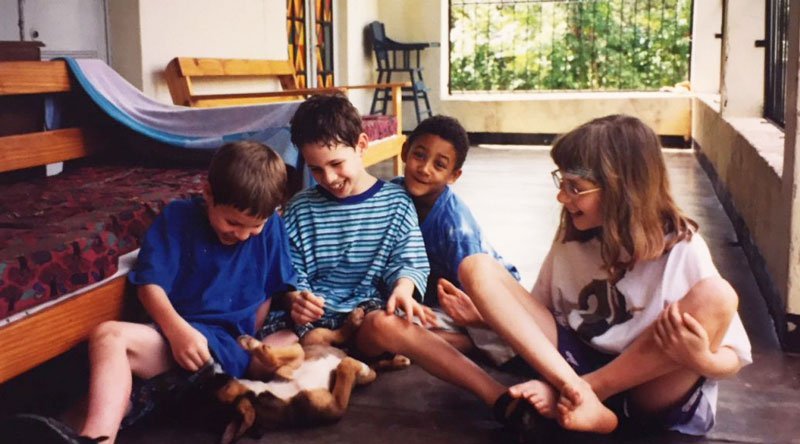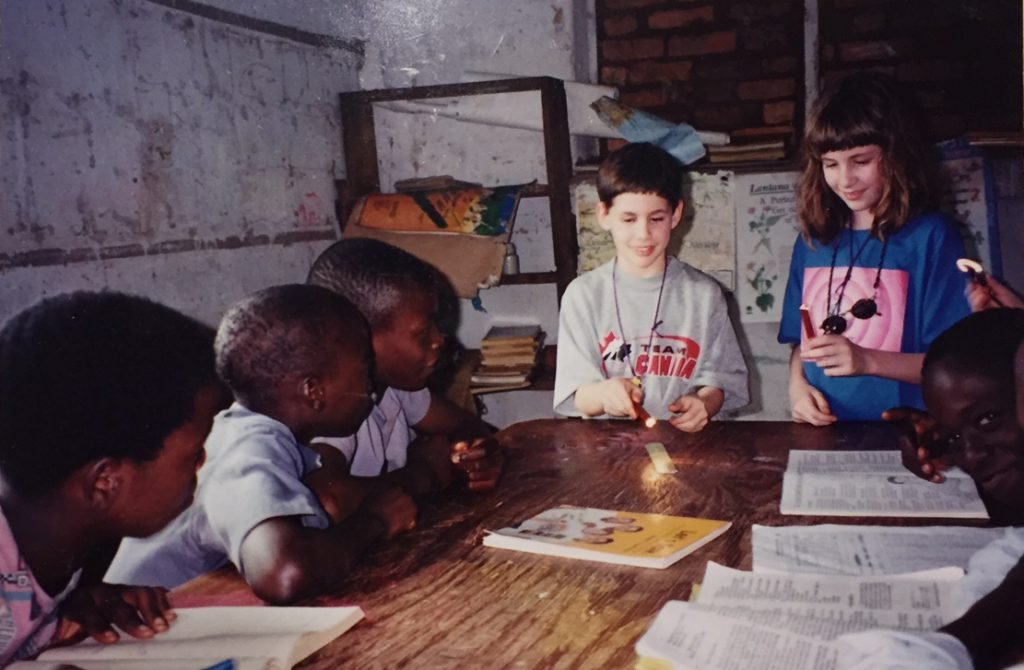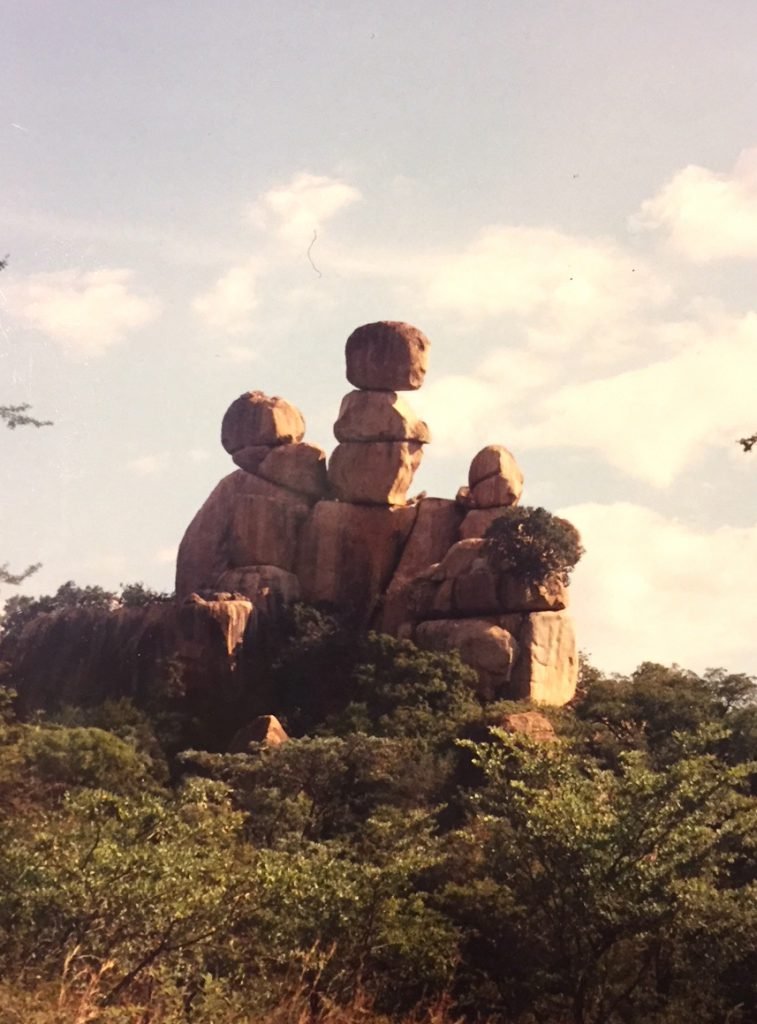
Backpacking in Africa With Kids
Many of our friends thought we were being wildly ambitious, if not outright irresponsible. Why would you want to take your young children on a 12-week backpacking trip to east and southern Africa, they asked. How can you justify them missing three months of school? Aren’t you going to dangerous places? What about the health risks? Are you guys nuts? Edmonton Journal librarian and friend Deb Dittrick was the frankest. “If someone told me I had to go on a trip like that I’d wake up screaming every night.”
As it turned out, our three kids adapted easily to the ups and downs of independent travel in Africa whether we were hiking in Zimbabwe and sleeping in caves, battling a swarm of tsetse flies in Tanzania, being routed by hungry and aggressive baboons in Malawi, or getting kicked off a bus at the Mozambique border in the blazing sun. Few days passed without some wondrous experience or wacky surprise, which suited us just fine.

I admit that handwashing your laundry, bouncing over wretched roads in over-stuffed, broken down buses and sleeping in rooms with abundant insect life isn’t everyone’s idea of a great vacation, but we didn’t consider it a vacation. We wanted a family adventure and that’s exactly what we got. We expected it to be hard and it was. As it turned out our family never had more fun, never met more interesting people, and never felt closer to each other than in those 12 crazy weeks in 1998. For us the daily surprises, the colourful characters we met, the astonishing sights we enjoyed, and our sense of camaraderie was more than worth the hardships. Twenty years later we all agree it was the best time we ever had as a family. You might say that the planning for this somewhat daring journey began back in 1984 in Burma. I had just finished trekking to Everest Base Camp in Nepal and spent a wonderful week in what is now called Mynamar, where I met an English woman named Philippa, whom I married the following year. I was talking to her one day in Mynamar when she asked, “Do you think it is possible to keep travelling after you have kids?” I thought about it for a few seconds before naively saying, “Yes, why not?” I had no idea then how challenging it would be, or how rewarding. Or how much research and planning it would take, although that was part of the fun. Luckily for all of us, Philippa was a phenomenally organized master planner and packer.
Maybe Philippa and I had something to prove to ourselves as well. That we weren’t just another aging, middle-class couple, shuttling our kids from music lessons to their soccer and hockey games in our minivan. We missed challenging and exotic journeys and felt we still had the gumption to rough it with the young backpacking crowd. After years of weighing alternatives, instead of just fantasizing around the campfire or the kitchen table about taking the family trip of a lifetime we decided to actually do it. But Africa? I’d made five trips to Africa and knew how rough it could be and how easy it is to get sick if you’re not careful – or even if you are. Philippa was convinced that with careful planning the health risks were manageable and we knew the children were good travellers. They proved themselves on earlier trips, especially that summer carrying packs up steep trails in Jasper National Park. Even if Rachel was only ten, Danny eight, and Sam, six, we believed they were ready for a challenging journey.

We decided to start in Zimbabwe, which was still fairly stable then and easy to get around with its superb train system. It had many great attractions such as Hwange National Park, Victoria Falls, the Matobo Hills, the lovely Eastern Highlands and the Chimanimani Mountains. Next would be Tanzania, the country with the greatest national safari parks in the world, plus the exotic island of Zanzibar, and finally Malawi, a very poor country which featured both the Mulanje Massif and beautiful Lake Malawi.

Yes, pulling the kids out of school was a difficult decision, but we believe they learned many things about themselves and about how people live in the developing world, something which can’t be taught very effectively in a classroom. They visited African schools, met volunteer workers, wildlife experts and many adult backpackers, rubbed shoulders with local people in hostels and on buses, trains and the back of a ridiculously crowded pickup truck. We all had great fun helping push buses and other vehicles we rode on out of the mud or the huge ruts in the dirt roads. The kids also kept up with their math homework and the older two did projects on the ecosystem of the Serengeti Plains.
The trip got off to a rough start. We arrived in Zimbabwe’s capital, Harare, seriously jet-lagged, and were picked up at the airport by someone from the backpacker’s lodge we had reserved space in. The kids were having fun there when some young women walked into a common room and said with open disgust, “Oh no, kids.” The owner apologized to us and suggested another backpacker’s lodge that catered to a more mature crowd.
Later that evening we went out to eat and had a small bag stolen in the restaurant, losing our plane tickets, Philippa’s journal and Rachel’s new camera, her primary Christmas present, plus other valuables. You are never more vulnerable when travelling directly to an exotic location than the first day or two, especially after a long flight. It takes some time to shake off the jet lag and adjust to the local rhythm of life in your new location. Then protecting your valuables becomes a habit. You have to find a balance between keeping a close eye on your gear and becoming paranoid. We had a kind of family conference that night. We were a bit shaken. But we learned our lesson and adjusted.
The next day we took the train east to Mutare, a quiet city, and stayed at a small hotel, which was mostly full of locals who befriended our children. Most backpackers avoided such places because they wanted to be with other backpackers, but we welcomed the contact with ordinary African people. The hotel had two dogs and three cats that the kids played with endlessly, along with a sweet young boy named Sebastien. We organized a variety of trips into the Eastern Highlands, seeing the Nyangombe Falls and the Pungwe Gorge. We also visited a nearby farm school where our children interacted with local kids and talked to the teachers.

A South African traveller with a car suggested we join him on a three-day hike in the Chimanimani Mountains. We were thrilled and we all had a great time, walking the trails, enjoying the views and sleeping in a cave. The next day we found a mountain hut and climbed through a window and stayed the night. On the way out we came across a black mamba, one of Africa’s deadliest snakes, and kept our distance.
Each of the kids had just $20 to spend on souvenirs and they made every cent count. They also did as much homework as was reasonably possible, kept journals full of daily observations, and glued in mementos, especially dozens of different beer labels we carefully pried off the bottles. I have always wondered what their teachers thought when they examined their journals.
Everywhere we went our kids were like magnets drawing friendly attention from local people and opening cultural doors for us. They always seemed to be adopting someone and giving them a nickname, like JoJo, a young British man their mother joked was a spy, which the kids happily embellished, and Jerkel, the manager of Doogles Backpackers Lodge, who originally said “I don’t cater to children” but soon fell under their spell. Then there was Sacko, a young Canadian man we met multiple times in Zimbabwe and Malawi. The kids voted Sacko their favourite traveller. They built up a list of all the quirky characters me met on our trip, both good and bad, and created their own Hall of Fame, voting on who would be immortalized as an official family legend. In the end thirteen people and three dogs were enshrined. There was the notorious Fat Lady who squeezed them out of their bus seats in Tanzania while devouring peanuts, the Full Montys, who left the shower door open and screamed when Philippa walked into the bathroom, and the evil Mr. Warthog, who stole Sam’s necklace in Zanzibar, and many others.

We had a wonderful time in Africa, but there was one very traumatic event. One night in Harare Sam suddenly became violently ill. He developed a high fever, a pounding headache and had chills. We rushed him to a top medical clinic which provided excellent care. We assumed it was malaria even though we were all taking Larium, the most effective anti-malarial. We realized the health risks before we left but nothing can prepare you for this kind of terrifying experience. The doctors dosed Sam with another anti-malarial, the standard treatment, plus broad spectrum antibiotics, as they were not sure he had malaria. Sam’s fever broke in less than 24 hours and after two tough days he was clearly recovering, attending his brother Danny’s ninth birthday party, which was an immense relief. After six days he took a 14-hour rickety bus ride to Malawi with no problems and after ten days he hiked up a steep trail for six hours, gaining 1,000 metres in altitude. Since it normally takes two weeks of treatment for malaria before recovering it is highly unlikely he had malaria. Could it be food poisoning from the pizza he ate a few hours before becoming sick, or some other food? Possibly. Food poisoning creates similar symptoms and people normally recover without treatment in a day or two. We will never know. Whatever it was it scared the hell out of us.

The highlight of the trip for the children was visiting the famous safari parks in Tanzania and Zimbabwe. They have always loved animals and they got to see huge numbers of Africa’s most famous ones. We travelled to Arusha, the Tanzanian city where safaris to those great national parks are booked, and purchased a seven day, six night trip to four parks, beginning with Lake Manyara. This was the real thing. No fences or cages. It was like paradise. There were many lions roaming about, plus elephants, wildebeests, buffalos, baboons and more. It was kind of embarrassing watching a pride of lions when a pair began vigorously mating. It seemed to last forever and there was plenty of grunting and groaning, or so it seemed as no one spoke a word. I wondered if they knew what they were watching but when I read Rachel’s and Danny’s journals after we got back home I realized they knew exactly what was going on.

The next day we crossed the Ngorongoro Crater on our way to the Serengeti. We were harassed a bit by Masai tribesmen who wouldn’t allow us to take a photo of their camels without paying. We saw thousands of animals in vast packs, including gazelles, antelopes and zebras roaming the great Serengeti Plains, plus a pack of hyenas and a pride of lions. Our children stared in awe, as did Philippa and I, though this was my second visit. There are some things you can watch again and again and this was one.

Over the next two days in the Serengeti we saw countless animals, predators and prey and visited a water hole with crocodiles and hippos. The final day was the best according to the kids. We saw a great number of sleek cheetahs, including a mother and cubs who took shelter from the sun by lying under another safari vehicle. A male cheetah stalked some Thompson gazelles and we saw twelve lions together, four males, four females and four cubs. For me the highlight of the entire safari was watching a secretary bird stomp a snake to death with its long powerful legs and then eat it. The kids were disgusted but fascinated by dozens of vultures feeding on a zebra carcass.

The final day at Tarangire National Park was a total bust. There were very few animals and the driver eventually admitted that almost all the animals were on the other side of a river that runs through the park, and the only bridge had been broken down and was unusable for a very long time. Our little minibus was invaded by tsetse flies that kept biting us, so the children and I took off our shoes and went on the attack killing dozens and dozens of them, while suffering the occasional painful bite. It was the highlight of our day and happily, we didn’t get sleeping sickness.

After a series of wild adventures in Malawi, which I will describe in posts to come, we returned to Harare and headed south for the last four or five days of our trip. After a day in Bulawayo we toured the magnificent Matopo Hills National Park, a world heritage site featuring ancient cave paintings and some of nature’s own fabulous sculptures, balancing granite boulders, teetering on top of one another, known as kopjes. Next we went to the spectacular Victoria Falls, observing it from both the Zimbabwean and the Zambian sides. Our final treat was one last safari in Hwange National Park, featuring 150 elephants at one water hole. We also watched multiple giraffes awkwardly bowing down for drinks. There were also hippos in the water. Afterwards we took the train to Harare and spent one final night at our favourite backpackers lodge, It’s a Small World, and left for home in the morning, where we began cooking up our next exotic family trip.
